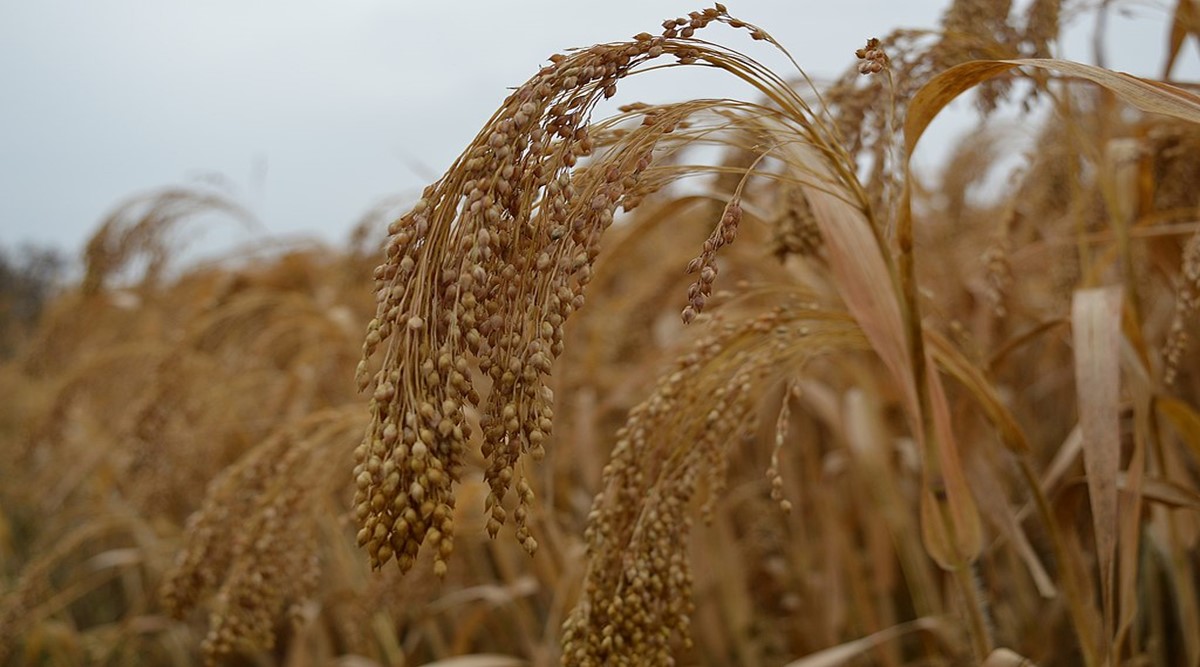 According to her, farming of millets deserves encouragement especially in view of their climate resilience, short cropping duration and ability to grow on poor soils, hilly terrains and with little rain.
(Wikimedia Commons)
According to her, farming of millets deserves encouragement especially in view of their climate resilience, short cropping duration and ability to grow on poor soils, hilly terrains and with little rain.
(Wikimedia Commons) Millets score over rice and wheat, whether in terms of vitamins, minerals and crude fibre content or amino acid profile. They are hardier and drought-resistant crops, with a short growing season (70-100 days, as against 120-150 for paddy/wheat) and lower water requirement (350-500 mm versus 600-1,200 mm).
Yet, these high-nutrient cereals — bajra (pearl millet), jowar (sorghum), ragi (finger millet), kodo (kodo millet), kutki (little millet), kakun (foxtail millet), sanwa (barnyard millet), cheena (proso millet), kuttu (buckwheat) and chaulai (amaranth) — aren’t the first choice of consumers and farmers.
For starters, kneading dough and rolling rotis is much easier with wheat. Even the branded “multi-grain” or “navratna” atta contains 60.6 per cent to 90.9 per cent whole wheat. The reason: Wheat has gluten proteins that swell and form networks on water being added to the flour, making the dough more cohesive and elastic when compared to gluten-free millets.
In rural India, the National Food Security Act of 2013, which entitles three-fourths of all households to 5 kg of wheat or rice per person per month at Rs 2 and Rs 3 per kg, respectively, has further reduced the demand for millets.
“For the rural poor, rice and wheat were aspirational foods. An expanded public distribution system has provided them access to these maheen anaaj (fine grains), which is distinguished from mota anaaj (coarse grains),” says Meera Mishra, Country Programme Officer for the International Fund for Agricultural Development (IFAD), a United Nations agency.
In April 2018, the Union Agriculture Ministry declared millets as “Nutri-Cereals”, considering their “high nutritive value” and “anti-diabetic properties” — 2018 was observed as “National Year of Millets”. Earlier this month, the UN General Assembly adopted an India-sponsored resolution to mark 2023 as the “International Year of Millets”.
Official promotion — millets were previously called “coarse cereals” — cannot, however, replace concerted marketing efforts. “We need better recipes to get millets on our plates and make them part of everyday food consumption. Companies coming out with ragi rava idli and ragi dosa breakfast mixes (these, again, contain wheat semolina and refined flour) are a good start,” says Mishra.
According to her, farming of millets deserves encouragement especially in view of their climate resilience, short cropping duration and ability to grow on poor soils, hilly terrains and with little rain.
IFAD has supported an initiative to revive kodo and kutki cultivation in Dindori district of Madhya Pradesh. The project was started in 2013-14, with 1,497 women-farmers from 40 villages — mostly from the Gonda and Baiga tribes — growing these two minor millets on 749 acres.
The identified farmers were supplied good-quality seeds and trained by scientists from the Jawaharlal Nehru Agricultural University in Jabalpur and the local Krishi Vigyan Kendra — on field preparation, line-sowing (as opposed to conventional broadcasting by hand) and application of compost, zinc, bavastin fungicide and other specific protection chemicals.
Further, a federation of farmers’ self-help groups undertook procurement of the produce and mechanical de-hulling — the traditional manual pounding process to remove husk from the grain was time-consuming.
“The number of farmers growing kodo-kutki in our project area has risen to 14,301 in 2019-20. So has the total acreage to 14,876 acres,” claims Mishra. This has been enabled by the federations — there are four now — taking up production of ‘kodo bars’ containing 33.4 per cent of these millets along with jaggery (25 per cent), soyabean (16.7 per cent), ghee (11.6 per cent), sesame (8.3 per cent) and groundnut (5 per cent). The kodo bars are being supplied to anganwadi centres in MP under an agreement with the state’s department of women and child development.
The IFAD project has helped in fighting malnourishment among children and reviving millet cultivation — crop yields are 1.5-2 times higher than before. But replicating the Dindori model beyond one district and across other millets remains a challenge.
- The Indian Express website has been rated GREEN for its credibility and trustworthiness by Newsguard, a global service that rates news sources for their journalistic standards.

